What’s inside this article: A look at the physical and cognitive benefits of exercise for children, instructions for an easy 8-minute workout for kids, and a free printable poster & printer-friendly instructions to use with your children. You’ll find the printable at the bottom of this article.
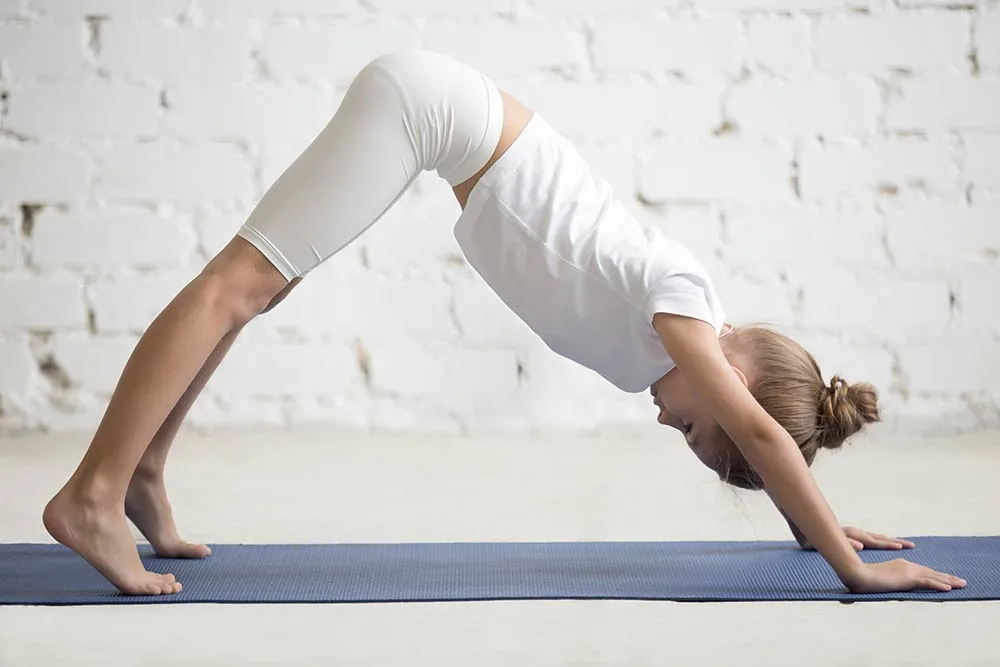
It’s no secret that children thrive on routine and structure. They also need physical activity for more reasons than you may realize. Have you thought about adding a morning workout to your kids’ routine?
Yes, I know mornings are already chaotic, especially school mornings. But what if I told you that committing to less than 10 minutes per day could drastically improve your child’s focus, attention, and overall learning?
Why Kids Should Exercise in the Morning?
Exercise plays a crucial role in children’s physical and cognitive development and well-being. Research shows children need at least 60 minutes of moderate to vigorous physical activity daily for optimum benefits.
Sure, an 8-minute workout is only 13% of their daily exercise requirements, but at a time when we’re often so busy, every bit counts, and those minutes add up!
Here are some of the many benefits of exercise for kids.
Physical Benefits of Exercise for Kids
- Gross Motor Development: Regular physical activity helps build gross motor skills, which involve the use of large muscle groups to perform movements such as walking, running, and jumping. Gross motor skills are important for everyday functions and help children improve their physical coordination.
- Improved Balance: Kids can improve their balance by engaging in exercises that challenge this skill. Balance helps kids perform everyday activities and enhances their ability to navigate the world safely.
- Improved Flexibility: Engaging in exercises that promote flexibility, such as stretching, yoga, or dance, helps children maintain a healthy range of motion in their joints.
- Increased Endurance: Regular, sustained physical activity builds cardiovascular and muscular endurance. Increased endurance allows kids to engage in activities for more extended periods without fatigue, supporting their overall fitness and energy levels.
- Better Motor Planning: Exercise challenges children to think ahead and plan their movements, improving their motor planning skills
- Enhanced Muscular Strength and Bone Density: Physical activities that involve resistance contribute to stronger muscles and denser bones. This is vital during childhood and adolescence, when bones are growing and developing.
- Boosted Immune System: Regular physical activity can strengthen the immune system, reducing the frequency of childhood illnesses like colds and flu.
- Improved Sleep Patterns: Physical activity contributes to better sleep quality and regulation, which is crucial for growth, learning, and development.
- Prevention of Chronic Conditions: Starting physical activity early in life sets a foundation for reducing the risk of chronic diseases such as diabetes, heart disease, and certain cancers later on.
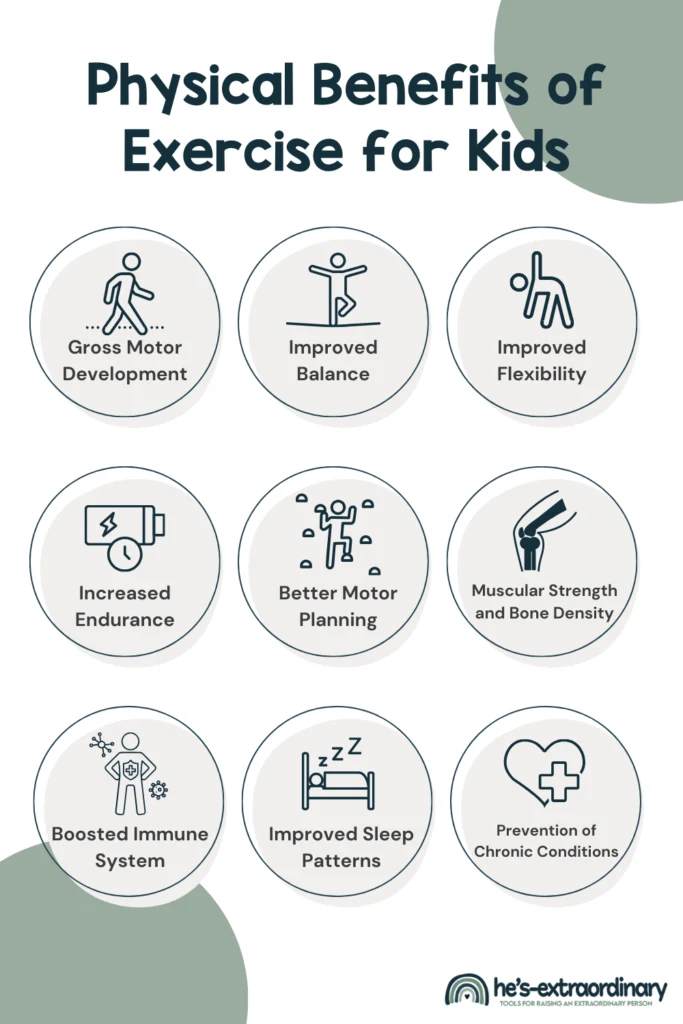
Cognitive Benefits of Exercise for Kids
Exercise is not only beneficial for the physical health of children but also plays a significant role in their cognitive development and emotional well-being.
- Improves Self-Regulation: Regular physical activity helps kids to regulate their emotions and behavior. It reduces cortisol and adrenaline (stress hormones) levels in the body and boosts endorphins (natural mood lifters).
- Reduces Hyperactivity and Fidgeting: For children with ADHD or autism, regular physical activity can be especially beneficial. It helps with sensory integration and provides an outlet for excess energy, reducing hyperactivity and fidgeting/.
- Improves Focus: Physical activity has been shown to enhance concentration and attention span in children. By increasing blood flow to the brain and releasing neurotransmitters like dopamine, exercise helps improve cognitive functions essential for learning and performing tasks.
- Decreases Anxiety & Boosts Mood: Exercise is a natural mood lifter. It triggers the release of endorphins, often referred to as feel-good hormones, which can reduce feelings of anxiety and depression. This biochemical process promotes a sense of well-being, relaxation, and happiness.
- Better Learning: Engaging in physical activity directly impacts cognitive abilities and academic performance. Exercise can lead to neurogenesis (the formation of new brain cells) and improve brain plasticity, which enhances learning capabilities. Physically active children tend to have better memory, quicker cognitive processing, and higher academic achievement.
- Enhances Creativity: Regular physical activity can also foster creativity in children. It provides mental breaks that allow for free thought and imagination, essential components of creative thinking and problem-solving.
- Improves Executive Function: Exercise has been linked to better executive function, which includes skills such as planning, organization, strategic thinking, and multitasking. These are crucial for academic success and daily life.
- Boosts Self-Esteem: By practicing and developing physical skills, kids gain confidence in their abilities, improving self-esteem and becoming more willing to try new things.

8-Minute Animal Workout For Kids
Here’s the new 8-minute morning workout.
This is a HIIT workout for kids just like my other workout, but the last move is more of a cool-down move.
One of the things kids love most about this workout is actually acting like the animal as they do the move, especially making the animal noises.
Don’t be afraid to jump in and do this with your child, and get everyone laughing at the same time.
What you need:
- Water
- Music
- A yoga mat
- Sneakers
- An interval timer (I use an app on my phone)
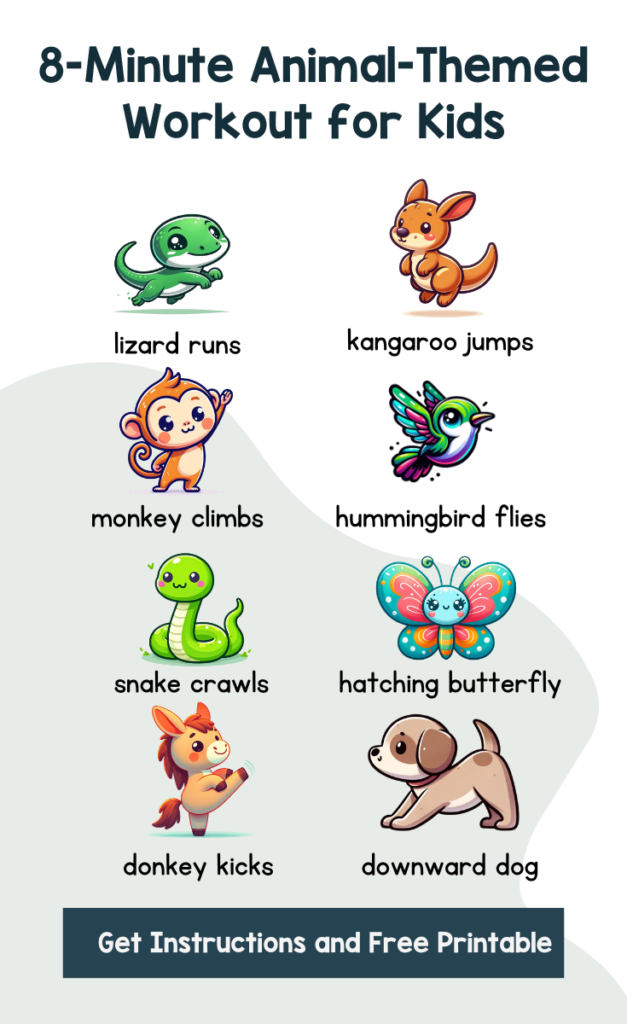
Instructions:
Set up your interval timer for 45 seconds of work and 15 seconds of rest for a total of 1 minute per move.
You and your kids should do as many of each move as possible during the 45 seconds (with the exception of the last move).
Your goal should be to break a sweat. That will be key in order to see optimum benefits from the workout.
1. Lizard Run
Start in a plank position.
You should have your hands (or forearms) on the floor, a straight back, and holding up your lower body with your toes.
You’re going to “run” as fast as you can, like a little lizard by bringing your knees up, one at a time, to your arms. (Picture a mountain climber)
This works the whole body, improves core strength, and practices bilateral coordination and motor planning.
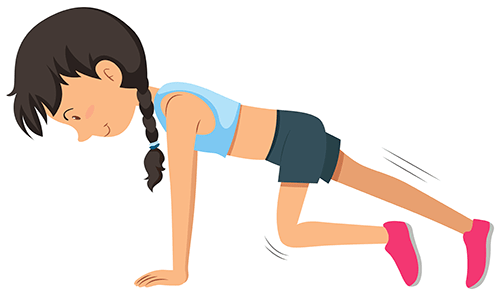
2. Monkey Climbs
Standing up straight again with legs slightly hip-width apart, bend your elbows so your hands are beside your shoulders.
Raise your right arm above your head while simultaneously raising your left knee to your hips.
Then, alternate by lowering your arm and knee and lifting the left arm above your head while also lifting the right knee.
To get an idea of what this looks like, imagine the lizard runs, but you’re standing and add in the arm movements, like a standing mountain climber.
This move is pretty advanced when it comes to motor planning and reciprocal bilateral coordination and may take some practice for your child so don’t worry if it looks uncoordinated, what’s important is that they’re having fun.
3. Hummingbird Flies
Stand up straight, with feet together. Stretch your arms straight out on either side of you (like a cross).
Then, you’re going to move your arms in very small circles. This is like windmills but with small, tight circles like a hummingbird quickly moving its wings.
This move is great for stimulating the joints in the arms and shoulders, which provides proprioceptive input.
Our body’s proprioceptive input receptors are located in the joints and tendons and are stimulated by pressure, stretching, and tension.
This helps improve body awareness.
4. Kangaroo Jumps
Start by standing straight, legs slightly less than hip-width apart.
Then, bend your knees to about a 45-degree angle and then spring yourself up, jumping in place as high as you can. Land with your knees back at the 45-degree angle and repeat.
This looks similar to a jump squat, but you aren’t going down as low. You can swing your arms out straight in front of you to help maintain your balance.
This move is great for building both endurance and balance.
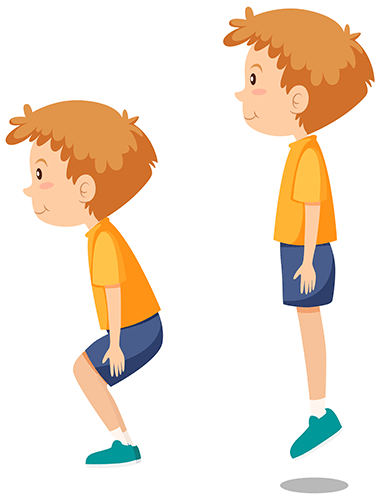
5. Snake Crawl
The rest of the workout is completed on the ground, but don’t worry, that doesn’t make it too easy.
For the snake crawl, prop yourself up on your forearms with your legs resting on the ground straight out behind you.
You shouldn’t be using your legs to support your body weight at all; they’re your long snake tail.
Use your forearms to drag yourself forward like a modified army crawl.
6. Hatching Butterfly
Start off by sitting on your bottom with your knees up in front of you.
Hug your knees into your chest and roll backward, curling up into a small ball. This is your cocoon.
Next, you’re going to “hatch” out of your cocoon like a butterfly by spreading your arms and legs out as far and wide as you can.
Your arms and legs should be hovering a few inches off the ground, using your abdominal muscles to support yourself.
This move helps build core strength and improve posture.
7. Donkey Kicks
This is the last high-intensity move in the workout. Start on your hands and knees and kick your leg out and up at a 90-degree angle. Alternate legs going as quickly as you can.
If you have the core and upper body strength to do it safely, try kicking both legs at the same time like a traditional donkey kick, temporarily supporting your weight with your arms and core.
8. Downward Facing Dog
Time to cool down.
Start with your hands and knees on the floor. Then, lift your knees off the floor, raising your buttocks high in the air, pushing your heels toward the ground and your palms flat on the ground.
You should be looking down so your head is completely inverted.
Hold the pose for 45 seconds or for the full minute, if you can.
This move works as a coo-down move at the end of the workout, and being upside down also provides a ton of vestibular input, which can help keep sensory seekers calm for hours.
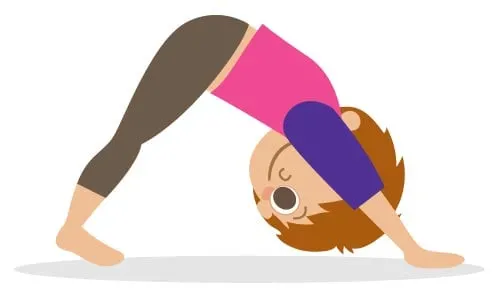
Download the Poster
If you’re ready to start incorporating this fun and easy workout into your child’s morning routine, download the free printable now.
This download includes the poster with the workout moves on it and a printer-friendly version of the instructions outlined above.
Morning Workout for KidsOther Workouts for Kids
If you haven’t downloaded the 7-minute HIIT workout for kids already, you can get it here.
You can also download this fun dinosaur workout for kids, too.

And you can also find an animal-themed gross motor game for kids here.

Maggie
Tuesday 21st of January 2020
When do you do these on a school morning? My kiddos take a bit to wake up, so first thing won’t work (at least at first!). Just curious what other family morning routines look like with this incorporated?
Nicole Day
Wednesday 22nd of January 2020
My kiddos have a visual routine they follow every morning. The order is they wake up, get dressed, eat breakfast, brush teeth and wash face, then we do either one of my two morning workouts, OR we do kids yoga from the cosmic kids youtube channel, then pack up and head to school.
8 minute morning workout for kids - adhd & autism resources for parents - Happy Healthy Child
Thursday 31st of October 2019
[…] Read more at 8 minute morning workout for kids – adhd & autism resources for parents. […]
Proprioceptive Input -40 Proprioceptive Input Activities for Sensory Seekers
Monday 14th of October 2019
[…] 8-minute workout for kids […]
Lauren
Friday 27th of September 2019
Hi there! We have loved adding in your 7-minute HIIT workout and are excited to add this one too. I'm having trouble with the link though? Is it working?
Nicole Day
Friday 27th of September 2019
Hi Lauren,
Please try clearing your browsers cache and then trying again. When I switched systems for online downloads recently, anyone who had used the downloads before the switch is getting an empty cart message. Clearing the cache of the old data seems to resolve the problem for most. If it doesn't work, e-mail me directly at [email protected]
52 Vestibular Input Activities For Sensory Seekers ·
Wednesday 18th of September 2019
[…] your child is a sensory seeker, a dose of vestibular input can literally keep them calm for hours. It can help them stay seated and focused at school when […]